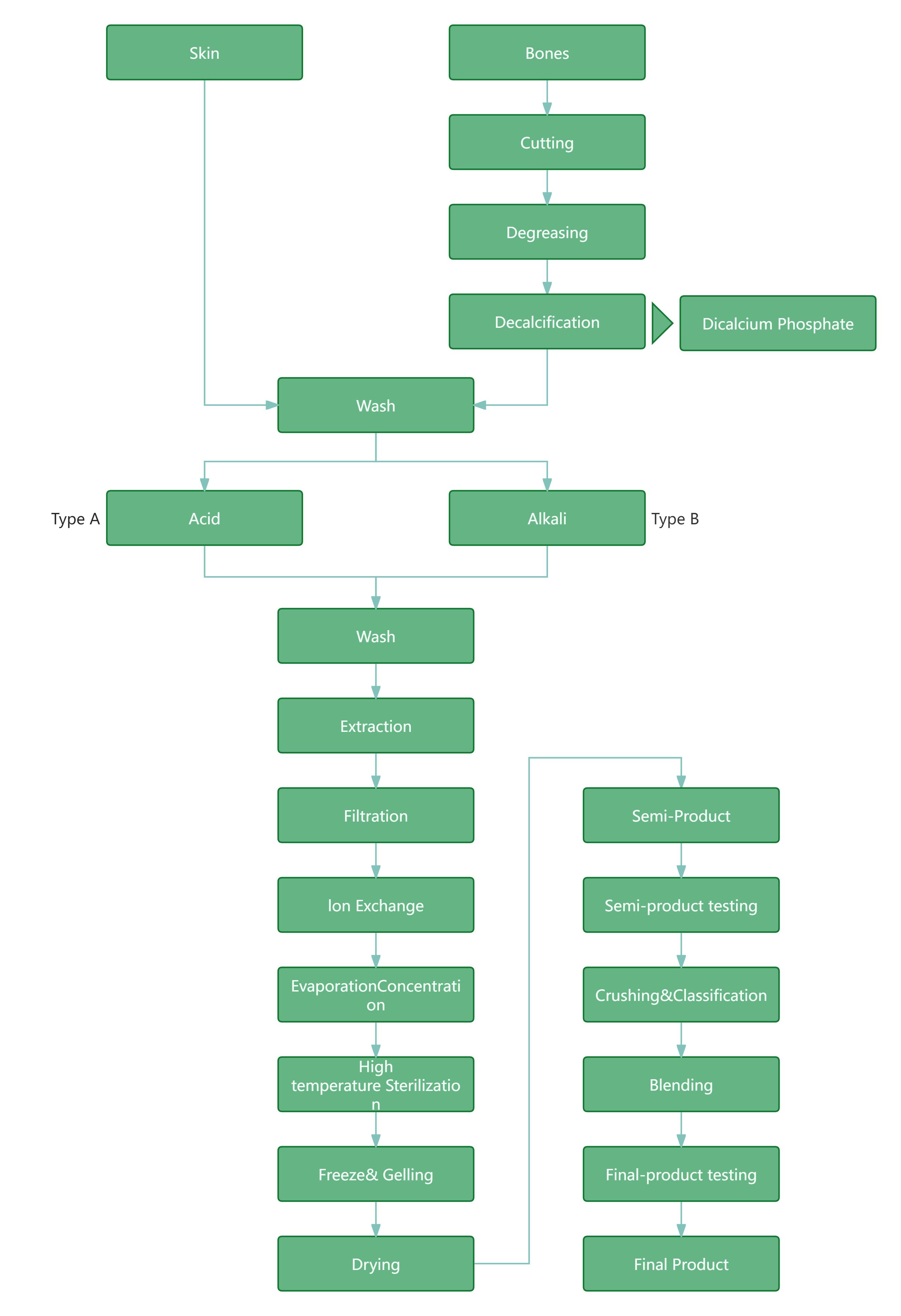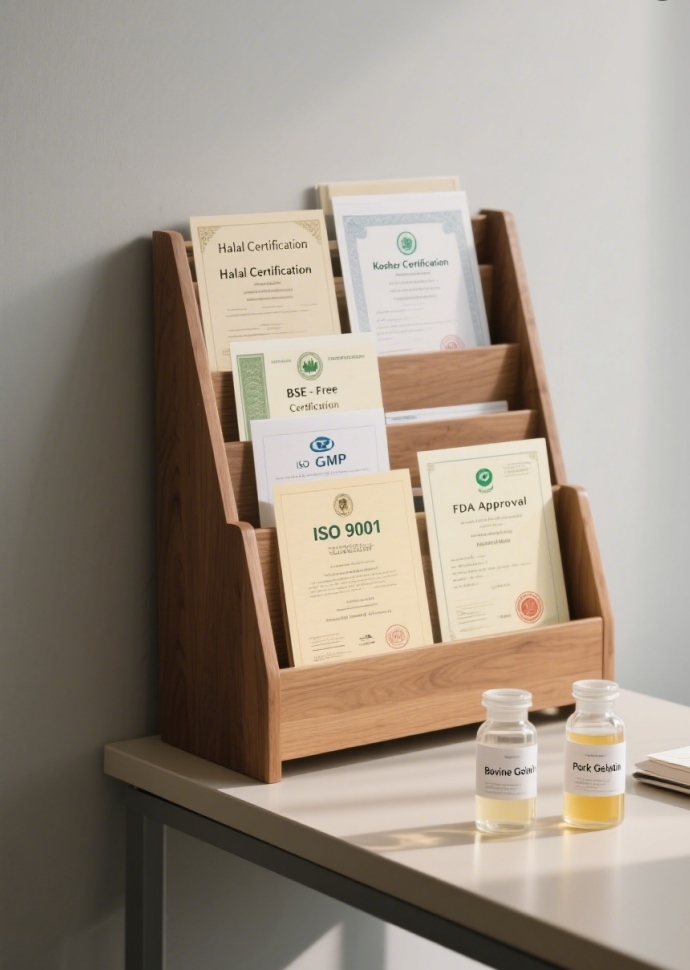Bovine Gelatin vs. Pork Gelatin: Which One Should You Choose?
When it comes to sourcing top gelatin for food or pharmaceutical applications, one choice definitely doesn’t fit all. Let’s roll up our sleeves and break down the nitty-gritty on bovine vs. pork gelatin, so you can hit the ground running and make the smartest procurement call.
1. Sourcing and Production Processes
- Source: Derived from cattle hides, bones, and connective tissues.
- Processing: Mostly undergoes an alkaline treatment (Type B), which results in a gelatin with a lower isoelectric point, making it suitable for neutral or slightly alkaline environments.
- Gel Strength: Typically offers firmer gels, with Bloom values ranging from 50 to 320, ideal for robust tablet coatings or softgel capsules that require extra durability.
- Source: Extracted from pig skins and bones.
- Processing:Mostly processed using an acid treatment (Type A), resulting in a gelatin with a higher isoelectric point, beneficial for acidic environments.
- Gel Strength: Forms slightly clearer and softer gels compared to bovine gelatin, with Bloom values generally between 160 and 300.
While most bovine gelatin on the market is Type B, processed via alkaline treatment, Type A bovine gelatin also exists and is derived from younger bovine hides using acid treatment—similar to the method used for pork gelatin. Conversely, Type B pork gelatin is theoretically possible, but due to low efficiency and high processing cost, it is rarely produced at scale.


2.Target Users & Applications
Bovine Gelatin:
- Food & Beverage: gummies, desserts, yogurt stabilizers
- Pharma: capsule shells, microencapsulation
- Technical: photographic films, cosmetics
Pork Gelatin:
- Food & Beverage: marshmallows, confectioneries, dairy products
- Pharma: specialty capsules (where bovine isn’t an option)
- Niche: halal/vegetarian markets generally avoid pork
Functional Differences
| Property | Bovine Gelatin | Pork Gelatin |
|---|---|---|
| Bloom Strength | Typically 50–320 Bloom | Typically 160–300 Bloom |
| Viscosity | Medium | Medium–High |
| Gelling Temp. | ~35–40 °C | ~30–35 °C |
| Set Time | Standard | Faster |
3.Certifications and Sourcing Considerations
As with any product, when sourcing gelatin—whether bovine or pork—it is essential to ensure that the supplier meets the necessary certifications and regulatory standards, especially if you're a food or pharmaceutical company looking to source high-quality gelatin. Below are key certifications to look out for:
Bovine Gelatin Certifications:
- Halal gelatine: Beef gelatin can be halal-certified if it is sourced from cows slaughtered according to Islamic law. This is crucial for catering to Muslim consumers and markets.
- Kosher gelatine: If the gelatin is derived from cows and processed according to Jewish dietary laws, it can be certified as kosher.
- BSE-Free Certification: Bovine Spongiform Encephalopathy (BSE) is a serious disease that affects cattle. Ensuring your bovine gelatin is sourced from BSE-free herds is important to avoid potential health risks and ensure the safety of your end products.
- ISO 9001 and GMP (Good Manufacturing Practices): These certifications ensure that the gelatin is produced under strict quality control standards, ensuring consistency and purity of the final product.
Pork Gelatin Certifications:
- Halal and Kosher Compliance: Pork gelatin will not be halal or kosher certified, making it unsuitable for Muslim and Jewish consumers. This is an important consideration for suppliers in religiously diverse markets.
- FDA Approval: In many countries, including the United States, pork gelatin is subject to approval by the Food and Drug Administration (FDA) for food use. Ensuring that your pork gelatin is FDA-approved is essential for compliance with food safety regulations.
- ISO 9001 and GMP: Like bovine gelatin, pork gelatin should be manufactured under certified quality systems to guarantee its safety and consistency.

4.Things to Keep in Mind When Sourcing Gelatin
When purchasing bovine or pork gelatin for use in food or pharmaceutical products, there are several factors to consider:
Traceability:
- Trace the source of the gelatin to ensure it comes from ethically sourced animals.We can provide you with the origin of gelatin, production process, factory COA, etc., to ensure that your gelatin meets both regulatory standards and the ethical standards of your company.
- Gelatin may have 10–25 day lead times, and MOQ of 1000 kg.
5.Wrapping Up
Choosing between bovine and pork gelatin isn’t just about price per kilo—it’s about matching raw-material traits, processing specs, and certification needs with your end product’s performance and your market’s dietary demands.
At gelkengelatin.com, we’ve got both bases covered—fully certified, batch-traceable, and ready to slide into your supply chain. Feel free to drop us a line for custom spec sheets, samples, or a deep-dive technical chat. We’re here to make your next product launch a smashing success!
Post time: Jun-12-2025







